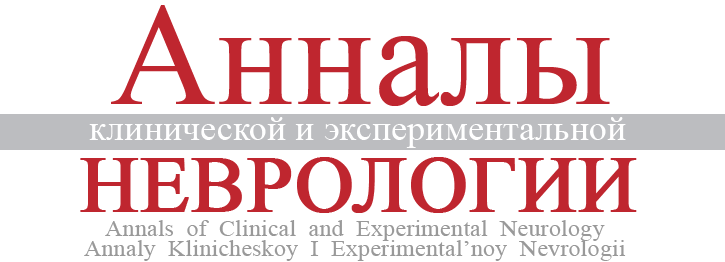Homocysteine is an amino acid with excitotoxic effect on the nervous system, and its elevated level is an independent risk factor for cerebrovascular disease and dementia. In order to evaluate pathogenic role of hyperhomocysteinemia in Parkinson’s disease (PD) we examined 102 patients and 50 control subjects by analyzing motor and cognitive functions in their relationships with the total plasma level of homocysteine. Among the examined patients, dementia was diagnosed in 58 persons. Mean homocysteine level in the demented PD patients significantly differed from that in PD patients without dementia (23.5±6.7 µmol/l vs. 12.9±2.8 µmol/l, respectively, p<0.05). Multivariate regression analysis showed strong positive correlation between homocysteine level and duration of the disease (r=0.63, p<0.001) and of levodopa therapy (r=0.71, p<0.001). We found strong inverse correlation between hyperhomocysteinemia and neuropsychological scores by MMSE (r=–0.64, p<0.001), FAB (r=–0.59, p<0.001) and clock drawing test (r=–0.35, p<0.001). At the same time, no correlation was found between daily L-dopa dose and plasma homocysteine level. Our study showed that hyperhomocysteinemia may contribute to the formation of cognitive decline in PD.
Hyperhomocysteinemia in Parkinson’s disease – new variant of complications of ongoing therapy or specific biochemical marker of the disease?
- Authors: Litvinenko I.V.1, Odinak M.M.1, Sologub O.S.1, Mogilnaya V.I.1, Schmeleva V.M.1, Saharovskaya A.A.1
-
Affiliations:
- S.M. Kirov Military Medical Academy
- Issue: Vol 2, No 2 (2008)
- Pages: 13-17
- Section: Original articles
- URL: https://www.annaly-nevrologii.com/journal/pathID/article/view/408
- DOI: https://doi.org/10.17816/psaic408
- ID: 408
Cite item
Full Text
Abstract
Keywords
About the authors
Igor V. Litvinenko
S.M. Kirov Military Medical Academy
Email: litvinenkoiv@rambler.ru
ORCID iD: 0000-0001-8988-3011
D. Sci. (Med.), Professor, Head, Department of nervous diseases, Chief neurologist of the Russian Ministry of Defense
Russian Federation, St. PetersburgMiroslav M. Odinak
S.M. Kirov Military Medical Academy
Email: trufanovart@gmail.com
Russian Federation, St. Petersburg
O. S. Sologub
S.M. Kirov Military Medical Academy
Email: litvinenkoiv@rambler.ru
Russian Federation, Saint-Petersburg
V. I. Mogilnaya
S.M. Kirov Military Medical Academy
Email: litvinenkoiv@rambler.ru
Russian Federation, Saint-Petersburg
V. M. Schmeleva
S.M. Kirov Military Medical Academy
Email: litvinenkoiv@rambler.ru
Russian Federation, Saint-Petersburg
A. A. Saharovskaya
S.M. Kirov Military Medical Academy
Author for correspondence.
Email: litvinenkoiv@rambler.ru
Russian Federation, Saint-Petersburg
References
- Голубев В.Л., Левин Я.И., Вейн А.М. Болезнь Паркинсона и синдром паркинсонизма. М.: МЕДпресссинформ, 1999.
- Зорилова И.В., Суслина З.А., Иллариошкин С.Н. и др. Мутация P1173L в гене метионин-синтазы (MTR) как причина гипергомоцистеинемии при ишемическом инсульте молодого возраста. Атмосфера. Нервные болезни 2004; 4: 33–35.
- Иллариошкин С.Н. Конформационные болезни мозга. М.: Янус К, 2003.
- Литвиненко И.В. Болезнь Паркинсона. М.: Миклош, 2006.
- Экстрапирамидные расстройства (ред. Шток В.Н., Иванова-Смоленская И.А., Левин О.С.). М.: МЕДпресссинформ, 2002.
- Burn D.J. Parkinson’s disease dementia: what’s in a Lewy body? J. Neural Transm. 2006; 70 (Suppl.): 361–365.
- Connelly P.J., Prentice N.P., Cousland G. et al. A randomised double-blind placebo-controlled trial of folic acid supplementation of cholinesterase inhibitors in Alzheimer’s disease. Int. J. Geriatr.Psychiatry 2007; 23: 1262–1263.
- den Heijer T., Vermeer S.E., Clarke R. et al. Homocysteine and brain atrophy on MRI of non-demented elderly. Brain 2003; 126: 170–175.
- Dufouil C., Alperovitch A., Ducros V. et al. Homocysteine, white matter hyperintensities, and cognition in healthy elderly people. Ann. Neurol. 2003; 53: 214–235.
- Durga J., van Boxtel M.P., Schouten E.G. Effect of 33year folic acid supplementation on cognitive function in older adults in the FACIT trial: a randomised, double blind, controlled trial. Lancet 2007; 369:208–224.
- Huang G., Dragan M., Freeman D. et al. Activation of catechol-O-methyltransferase in astrocytes stimulates homocysteine synthesis and export to neurons. Glia 2005; 51: 47–55.
- Jellinger K.A. The morphological basis of mental dysfunction in Parkinson’s disease. J. Neurol. Sci. 2006; 248: 167–172.
- McMahon J.A., Green T.J., Skeaff C.M. A controlled trial of homocysteine lowering and cognitive performance. N. Engl. J. Med. 2006; 354: 2764–2772.
- Oishi N., Hashikawa K., Yoshida H. Quantification of nicotinic acetylcholine receptors in Parkinson’s disease with (123) II5IA SPECT. J. Neurol. Sci. 2007; 256: 52–60.
- O’Suilleabhain P.E., Sung V., Hernandez C. et al. Elevated plasma homocysteine level in patients with Parkinson disease: motor, affective, and cognitive associations. Arch. Neurol. 2004; 61: 865–868.
- Rogers J.D., Sanchez-Saffon A., Frol A.B. et al. Elevated plasma homocysteine levels in patients treated with levodopa: association with vascular disease. Arch. Neurol. 2003; 60: 59–64.
- Sachdev P. Homocysteine, cerebrovascular disease and brain atrophy. J. Neurol. Sci. 2004; 226: 25–29.
- Wright C.B., Paik M.C., Brown T.R. et al. Total homocysteine is associated with white matter hyperintensity volume: the Northern Manhattan Study. Stroke 2005; 36: 1207–1211.
- Zieminska E., Lazarewicz J.W. Excitotoxic neuronal injury in chronic homocysteine neurotoxicity studied in vitro: the role of NMDA and group I metabotropic glutamate receptors. Acta Neurobiol. Exp.(Wars.) 2006; 66: 301–309.
Supplementary files








